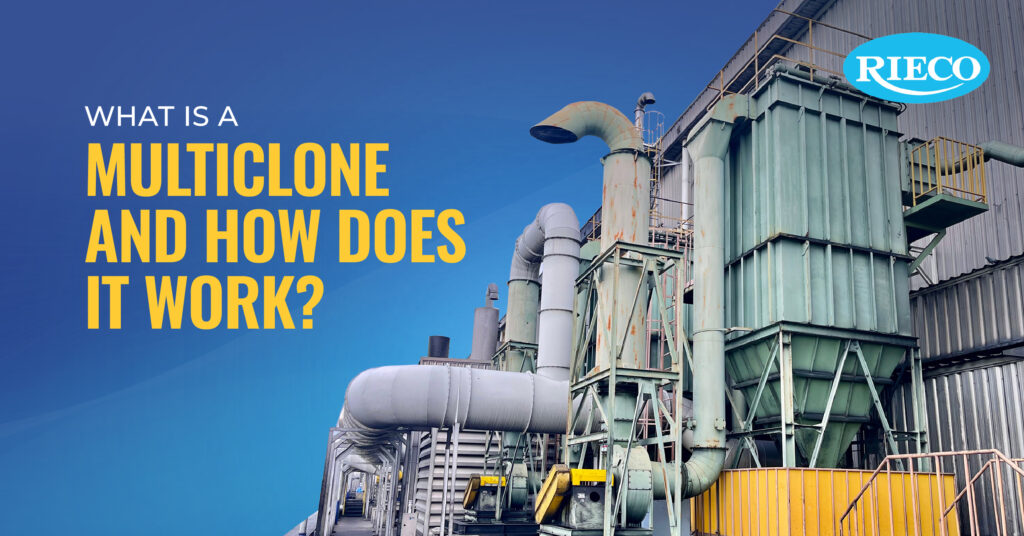What is a Multiclone and How Does It Work?

Air Pollution Control
Dust and particulate emissions are by-products of almost every heavy industrial process. From biomass boilers to cement kilns, managing these emissions is both a regulatory necessity and an operational priority. Among the many solutions available, multiclone dust collectors stand out as a proven, cost-effective technology for efficiently removing particulates from exhaust streams. Multiclones act as a pre-cleaning system, protecting downstream equipment and reducing energy consumption. They also support long-term compliance with environmental norms.
What is a Multiclone?
A multiclone is an air pollution control device that combines the principles of multiple cyclones into a single unit. Instead of relying on one large cyclone chamber, a multiclone uses numerous small cyclones arranged in parallel to capture dust and ash particles from the gas stream.
This parallel arrangement allows for higher efficiency compared to a single cyclone. Multiclones are widely used on biomass boilers, cement plants, and lime kilns, where they can remove up to 85% of particulates from boiler exhaust. They are often considered the “unsung workhorses” of industrial air pollution control systems.
Key Components of a Multiclone Dust Collector
A multiclone dust collector consists of several essential parts, each contributing to its efficiency:
- Cyclone Tubes (Clones): Small, high-efficiency cyclones arranged in parallel.
- Inlet Plenum: The chamber where contaminated air enters before distribution.
- Spinners: Specially designed components that guide airflow into a spiral motion.
- Vortex Finder: A tube that allows cleaned air to exit at the top of each cyclone.
- Dust Hopper: Collection chamber at the bottom where particles settle after separation.
- Casing/Enclosure: Provides structural integrity and ensures the system remains airtight.
Modern designs use larger cyclone tubes and advanced spinners, which not only improve efficiency but also simplify maintenance.
How Does a Multiclone Work?
The working principle of a multiclone is based on centrifugal force:
- Entry: Dust-laden gases enter the common inlet plenum.
- Distribution: Air is directed into multiple cyclone tubes.
- Cyclone Action: Inside each tube, the air spins rapidly in a vortex. Heavier particles are forced outward against the cyclone wall.
- Separation: Dust and ash slide down into the hopper at the bottom.
- Clean Air Exit: The cleaned gas stream rises through the vortex finder and exits the system.
By running many such small cyclones in parallel, the multiclone achieves high separation efficiency while maintaining a compact footprint.
The Importance of Multiclones in Industrial Emission Control
Industrial emissions are subject to stringent environmental regulations in India and worldwide. Installing a multiclone dust collector helps plants achieve compliance without compromising production output.
Key reasons for adoption include:
- Reducing load on the primary air cleaning equipment by eliminating some dust load at the initial stages.
- Preventing regulatory penalties for non-compliance.
- Reducing maintenance costs for downstream equipment by lowering the particulate load.
- Improving operational reliability with fewer unplanned shutdowns.
- Supporting sustainable practices through efficient emission control.
Key Benefits of Using a Multiclone
Multiclones offer a unique balance of performance, affordability, and durability. Some of the standout benefits include:
- Enhanced Regulatory Compliance
They help industries meet stringent air quality standards by removing up to 85% of particulates from exhaust streams. This compliance safeguards businesses from potential fines, shutdowns, and reputational damage. - Cost-Effective Solution
Compared to high-investment systems like baghouses, multiclones provide an affordable entry point into emission control. Their relatively simple design makes them less expensive to install and operate. - Improved Equipment Protection
By filtering coarse dust particles before they reach sensitive downstream units such as ID fans or scrubbers, multiclones significantly reduce erosion, wear, and unplanned downtime. - Energy Efficiency
Reducing the particulate load on secondary systems lowers energy consumption, translating into lower operating costs. - Durability and Long Service Life
Built with robust materials, modern multiclones can withstand harsh conditions, including high temperatures and abrasive dust. This ensures reliability over long operating cycles. - Simplified Maintenance
Larger tube designs and straightforward access points make modern multiclones easier to inspect and maintain, reducing labour costs and downtime. - By-Product Recovery
Some industries, like biomass plants, can reclaim useful by-products such as char for re-injection systems, adding a layer of economic value to the collection process.
Industries Where Multiclone Plays a Key Role
Multiclones are versatile and find application in a wide range of industries:
- Biomass Power Plants: For removing ash and char from boiler exhaust.
- Cement & Lime Plants: To control dust emissions during kiln operations.
- Metallurgical Units: For capturing coarse particles in smelting and refining.
- Paper & Pulp Mills: To reduce particulate emissions from recovery boilers.
- Chemical Processing Plants: For handling high-dust exhaust streams.
By functioning as an effective pre-cleaning device, multiclones extend the lifespan of more advanced dust collectors installed downstream.
Bottom Line
A multiclone is much more than just a dust collector; it is a critical component in modern industrial emission control strategies. By understanding what is a multiclone, plant managers can make informed choices about cost-effective emission control solutions. For industries looking to balance efficiency, compliance, and cost-effectiveness, investing in a high-quality multiclone is a smart choice.
At Rieco, we have developed a Multiclone Dust Collector that goes beyond conventional designs. With decades of expertise in dust collection design, our multiclones are engineered for reliability and performance.




